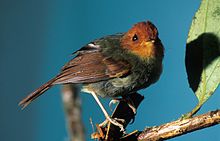| Rufous-headed pygmy tyrant | |
|---|---|

| |
| Conservation status | |
 Least Concern (IUCN 3.1) | |
| Scientific classification | |
| Domain: | Eukaryota |
| Kingdom: | Animalia |
| Phylum: | Chordata |
| Class: | Aves |
| Order: | Passeriformes |
| Family: | Tyrannidae |
| Genus: | Pseudotriccus |
| Species: | P. ruficeps |
| Binomial name | |
| Pseudotriccus ruficeps (Lafresnaye, 1843) | |

| |
The rufous-headed pygmy tyrant (Pseudotriccus ruficeps) is a species of bird in the family Tyrannidae, the tyrant flycatchers. It is found in Bolivia, Colombia, Ecuador, and Peru with at least one record in Venezuela.
Taxonomy and systematics
The rufous-headed pygmy tyrant was originally described as "Musicapa (Todirostrum?) ruficeps". It was later moved to the monotypic genus Caenotriccus which in the middle of the twentieth century was merged into Pseudotriccus.
The rufous-headed pygmy tyrant has no subspecies. However, the population in central Peru is treated by some authors as subspecies P. r. haplopteryx, and populations further south are suspected to be a separate species.
Description
The rufous-headed pygmy tyrant is about 11 cm (4.3 in) long and weighs 7 to 9 g (0.25 to 0.32 oz). The sexes have the same plumage. Adults have an entirely bright orange-rufous head and throat. Their upperparts are dark olive and their tail dull chestnut. Their wings are dark dusky with wide dull chestnut edges; the wings appear fully chestnut. The central Peruvian population has browner wings. Their breast and flanks are grayish olive and the center of their belly and their undertail coverts creamy yellow. Both sexes have a dark brown iris, a black maxilla, a mostly yellowish mandible, and gray legs and feet. Juveniles are mostly dark olive, with a brownish olive head, rufous-brown wings, and a whitish chin.
Distribution and habitat
The rufous-headed pygmy tyrant has a disjunct distribution. In Colombia it is found in parts of all three Andean ranges. In Ecuador it continues from Colombia on the western Andean slope south into Pichincha Province and separately further south between Guayas and El Oro provinces. It also occurs on the eastern Andean slope for essentially the whole length of Ecuador into Peru. Its range continues through Peru on the eastern slope and into Bolivia as far as Cochabamba Department. There is a single audio recording from 1986 in Apure, Venezuela, almost on the Colombian border.
The species inhabits humid montane forest and cloudforest in the temperate and subtropical zones, where it favors vine thickets and the forest borders. In elevation it occurs mostly between 2,000 and 3,150 m (6,600 and 10,300 ft) in Colombia (though as low as 400 m (1,300 ft) in the southwest), mostly between 2,000 and 3,300 m (6,600 and 10,800 ft) in Ecuador, and between 2,000 and 3,350 m (6,600 and 11,000 ft) in Peru.
Behavior
Movement
The rufous-headed pygmy tyrant is a year-round resident.
Feeding
The rufous-headed pygmy tyrant feeds on insects and other arthropods. It usually forages singly or in small groups. It hunts near the ground in dense undergrowth, making short flights between perches, and jumping up from a perch to take prey from leaves and twigs with an audible snap of the bill.
Breeding
The rufous-headed pygmy tyrant appears to breed before and maybe into June in Colombia and between July and March in eastern Peru, but details are lacking. Nothing else is known about the species' breeding biology.
|
Songs and calls Listen to the rufous-headed pygmy tyrant on xeno-canto |
Vocalization
The rufous-headed pygmy tyrant's song has been described as "a protracted and very high-pitched trill, at first descending, then ascending, 'tsi-i-i-i-i-i-e-e-e-u-e-e-e-i-i-i-i?' " and its call as "a sharp and drawn-out, rattled 'tzrrrrrrrrrrrr' ". The song has been similarly described a "a deep, descending trill followed abruptly by a rising, higher-pitched trill" grrrrrrew'REEEEEEE?" and its call as "a deep, growling trill".
Status
The IUCN has assessed the rufous-headed pygmy tyrant as being of Least Concern. It has a large range; its population size is not known and is believed to be decreasing. No immediate threats have been identified. It is considered rare in Bolivia, fairly common to common in Peru, and common in Colombia. It occurs in several protected areas, but is "robably locally extinct in areas where deforestation has been intense, e.g. in SW Ecuador".
References
- ^ BirdLife International (2024). "Rufous-headed Pygmy Tyrant Pseudotriccus ruficeps". IUCN Red List of Threatened Species. 2024: e.T22698829A264369355. Retrieved 30 October 2024.
- ^ Gill, Frank; Donsker, David; Rasmussen, Pamela, eds. (August 2024). "Tyrant flycatchers". IOC World Bird List. v 14.2. Retrieved 19 August 2024.
- ^ Remsen, J. V., Jr., J. I. Areta, E. Bonaccorso, S. Claramunt, G. Del-Rio, A. Jaramillo, D. F. Lane, M. B. Robbins, F. G. Stiles, and K. J. Zimmer. Version 28 September 2024. A classification of the bird species of South America. American Ornithological Society. https://www.museum.lsu.edu/~Remsen/SACCBaseline.htm retrieved September 29, 2024
- ^ Parrish, Chris (January 5, 1986). "XC6128 Rufous-headed Pygmy Tyrant Pseudotriccus ruficeps". xeno-canto. Retrieved October 30, 2024.
- de LaFresnaye, M.F. (1838). Revue zoologique. Société cuvierienne. p. 291.
- ^ Fitzpatrick, J. W. (2020). Rufous-headed Pygmy-Tyrant (Pseudotriccus ruficeps), version 1.0. In Birds of the World (J. del Hoyo, A. Elliott, J. Sargatal, D. A. Christie, and E. de Juana, Editors). Cornell Lab of Ornithology, Ithaca, NY, USA. https://doi.org/10.2173/bow.rhptyr1.01 retrieved October 30, 2024
- ^ Schulenberg, T.S.; Stotz, D.F.; Lane, D.F.; O'Neill, J.P.; Parker, T.A. III (2010). Birds of Peru. Princeton Field Guides (revised and updated ed.). Princeton, NJ: Princeton University Press. p. 422. ISBN 978-0691130231.
- ^ McMullan, Miles; Donegan, Thomas M.; Quevedo, Alonso (2010). Field Guide to the Birds of Colombia. Bogotá: Fundación ProAves. p. 151. ISBN 978-0-9827615-0-2.
- ^ Ridgely, Robert S.; Greenfield, Paul J. (2001). The Birds of Ecuador: Field Guide. Vol. II. Ithaca: Cornell University Press. p. 478. ISBN 978-0-8014-8721-7.
| Taxon identifiers | |
|---|---|
| Pseudotriccus ruficeps |
|
